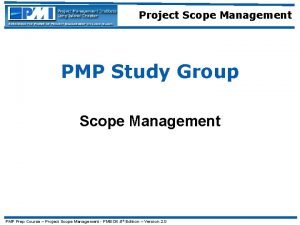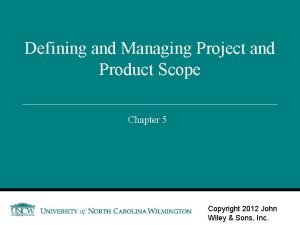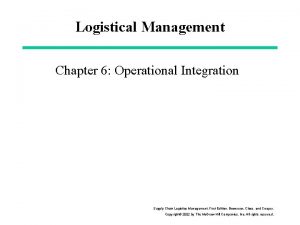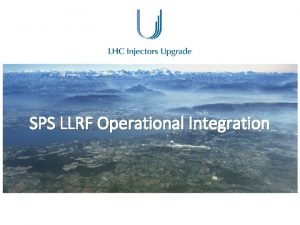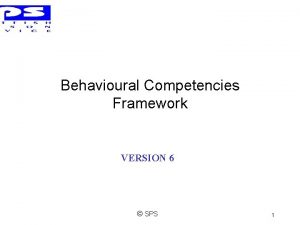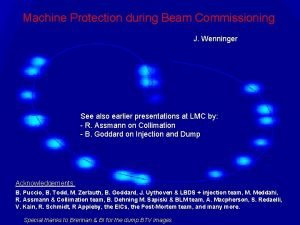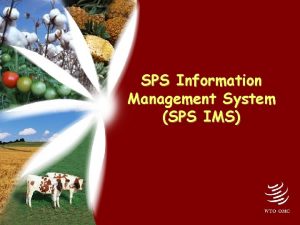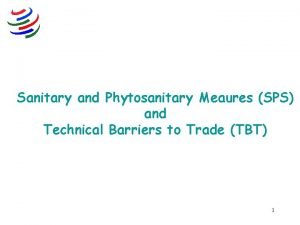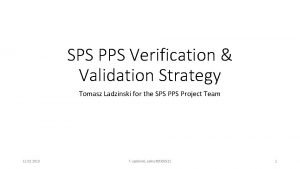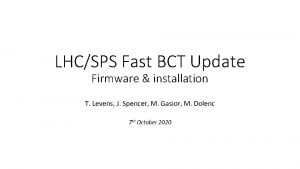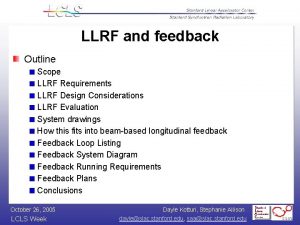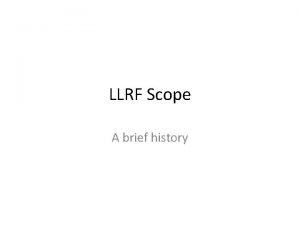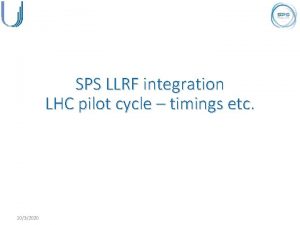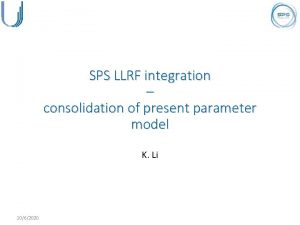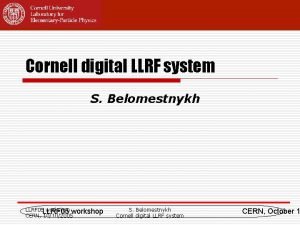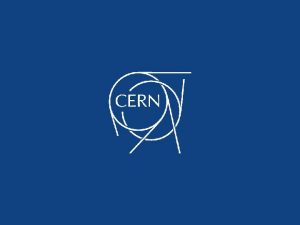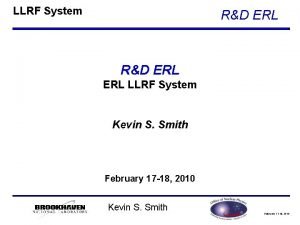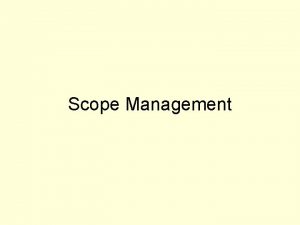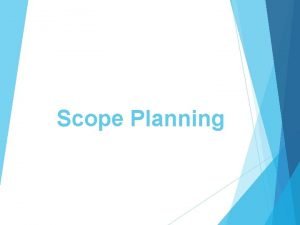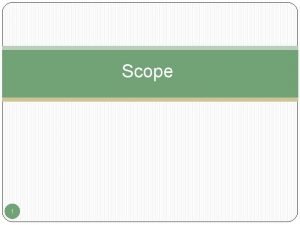SPS LLRF Operational Integration LLRF Operational Integration Scope












- Slides: 12

SPS LLRF Operational Integration

LLRF Operational Integration • Scope • With the RF power upgrade after LS 2 there will also be a complete renovation of the LLRF system. The existing system will be mostly replaced by an entirely new system based on new and modern hardware. • The upgrade comes with many new capabilities – this comes with the chance to plan and perform the integration of the LLRF system monitoring and control into the operational environment in the CCC right from the start. • Goal: • We want to use this chance as OP to participate early during the development, installation and deployment of the new system to target for a good and high level integration of the new LLRF system into the operational environment: • Good integration into the present system (via LSA – value generators, make rules, work with high level parameters) • Good high level display of status, faults, consistency verification • Good and easy control, where necessary (i. e. RF on/off, switch between single/multi bunch. . . ) • Method: • Identify the different tasks and required functionality for the various SPS beams and cycles as well as required diagnostics to set up/monitor • For this, we have set up a small working group with members from SPS OP, RF LL, RF software, RF beam dynamics • At a later stage will also need input from ABT, BI, CO 9/17/2020

Meetings • Common understanding so far: • The new LLRF system will be much more self-contained. Once provided with the necessary information (which we are evaluating… cycle type, beam type etc. ), it should be able to set itself up and run rather autonomously. • E. g. manual switching between single/multi-bunch not necessary • Monitoring and corresponding diagnostics still required by RF expert – this has already been defined to a large extent (see LLRF Review in March 2018 https: //indico. cern. ch/event/708428/ ). • Access to the system for OP will be at a very high level. The interface should provide simple and fast status monitoring and control and access to trims via physics parameters. • WG Meetings held to date: • • Discussed system requirements based on representative sets of SPS cycles Discussed changes and possibilities with the new system Discussed required parameter model Discussed beams needed for commissioning after LS 2 • Open topics to be discussed • • • 9/17/2020 Diagnostics requirements for experts and OP Feedforward, longitudinal feedbacks and RF blow-up Planning and scheduling for system tests, dry runs, integration tests Ions and FFA – slip stacking Distribution of RF signals

Outcomes – 1 • Run-through LHC cycles / SFTPRO features also included • Sequence management – timing setup • One of the most complicated elements of todays system, mainly in consequence of the hardware implementation, is the management of the sequences/timing events necessary to perform certain LLRF actions • The new system will have most of these sequences integrated at a low level, exposing only the high level timing necessary for operation The new system will expose timing events to manage and to monitor the status of: • • • RF on/off Loops on/off Feedbacks on/off Debunching on/off Bunch rotation 1 on/off (via stable phase) Bunch rotation 2 on/off (via voltage) Each of these timings will take up to 8 values to enable up to 8 times switching of any process 9/17/2020

Outcomes – 2 • Run-through LHC cycles / SFTPRO features also included • Synchro loop • CPS synchronization? Rephasing – not yet discussed! • LHC synchronization? • A frequency program will be calculated internally from the B-train signal (distribution via WR network) – a B 0 value will have to be provided by OP • Radial loop • The radial loop will work based on the same principle as today – the sampling will be at a much higher rate with several samples per bunch. • Transition crossing • Switching from synchro to radial loop will be done automatically – this will also be available automatically in the presence of active radial steering chroma measurement throughout the cycle no longer a problem for FT and ions • An initial function for the voltage step at transition will be programmed. Fine tuning will be possible after as the voltage function will be kept fully generic (no parametrization). • Phase jump – for the moment discrete, via timing event • Other? 9/17/2020

Outcomes – 2 • Run-through LHC cycles / SFTPRO features also included • Synchro loop • CPS synchronization? Rephasing – not yet discussed! • LHC synchronization? • A frequency program will be calculated internally from the B-train signal (distribution via WR network) – a B 0 value will have to be provided by OP • Radial loop • The radial loop will work based on the same principle as today – the sampling will be at a much higher rate with several samples per bunch. Control of loops will finally be done via timings – potentially adding loop gains • Transition crossing via timings, voltage function, phase jump timing (or function? ) • Switching from synchro to radial loop will be done automatically – this will also be available automatically in the presence of active radial steering chroma measurement throughout the cycle no longer a problem for FT and ions • An initial function for the voltage step at transition will be programmed. Fine tuning will be possible after as the voltage function will be kept fully generic (no parametrization). • Phase jump – for the moment discrete, via timing event • Other? 9/17/2020

Outcomes – 2 • Run-through LHC cycles / SFTPRO features also included • Phase loop will be based on a direct sampling • The phase loop will act turn-by-turn on a defined average (default full batch – to be parameterized…) • S/M parameters will become obsolete • Injection needs to be managed carefully, however, and will require as input a bunch mask to prevent the loop perturbing circulating bunches upon injection of a new batch. It has been agreed that, for this to work, OP needs to provide arrays with: • Injection bucket number • Number of injected bunches • Filling pattern of injected batch (25 NS, 50 NS, 8 B 4 E, …) • To make this available dynamically will require an upgrade of the timing system OP needs to provide new parameters and functionality during cycle generation and playback • Number of injections (dynamical) • Number of bunches • Filling patterns 9/17/2020

Outcomes – 3 • Run-through LHC cycles / SFTPRO features also included • RF blow-up discussed briefly • Most high level parameters are already in LSA today • Frequency • Amplitudes • Frequency windows • Some changes/optimizations were under discussion by RF experts • Longitudinal damper, feedbacks and feedforward has been discussed briefly RF blow-up: operationally we adjust the amplitude and scaling factor, observing the bunch length Longitudinal damper, feedbacks and feedforward: need to set up one-turn-delay – this is done by the experts. After this, OP will just need timings and the gain function as for the RF loops 9/17/2020

Outcomes – 4 • Run-through LHC cycles / SFTPRO features also included • Diagnostics was also already mentioned • An exhaustive list was presented by Giulia at the LLRF Review in March 2018 (https: //indico. cern. ch/event/708428/ ) • Re-cap of the main items • • • SPS 2 PS frequency measurement (frev) Inj. Bucket counter Synchro loop error Phase loop error CP extr. warning SPS inj. pulse Mountain range Bunch length from BQM/ABWLM Peak detected Phase sampling counter The direct sampling of the new phase loop will give lots of new signal Can get bunch-by-bunch batch-by-batch injection signals Need to think about buffers for diagnostics and display as well as data acquisition control 9/17/2020

Outcomes – 5 • Beams needed for commissioning • It became clear that the initial setting up of the new RF system will be very time consuming • The first milestone will be the RF capture of a single bunch requires lots of fiddling with signals and delays for time alignment • For this reason, the first beam required is an LHC INDIV ideally at Q 26; this will be followed by acceleration of a nominal LHC INDIV (Q 20) • After establishment of golden orbits and trajectories, we should have the low intensity FT beam (Q 26) and an nominal LHC INDIV (Q 20) at flat top for beam based alignment; then start setting up rephrasing and extraction • Finally we move to multi-bunch beams (scrubbing) and acceleration thereof A document has been circulated with a proposal for a commissioning sequence – currently waiting for input from RF (Philippe will comment in the next meeting to be held this afternoon) 9/17/2020

Status and next steps Status To be treated Parameter model Re-phasing November RF loops RF blow-up October Longitudinal feedback & feedforward October Special processes (gymnastics, de-bunching, …) Diagnostics October RF signals distribution November Testing and commissioning November Beams for post-LS 2 re-commissioning October 800 MHz review Done 9/17/2020 Started Still open

